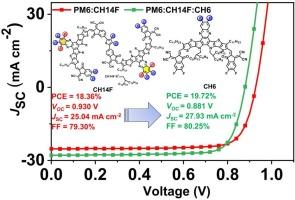14外围氟化二聚体受体使有机太阳能电池达到19.7%的效率
IF 17.1
1区 材料科学
Q1 CHEMISTRY, PHYSICAL
引用次数: 0
摘要
低聚小分子受体(OSMA)结合了小分子受体(SMA)和聚合受体(PSMA)的优点,包括明确的分子结构、高玻璃化转变温度和低扩散率。然而,分子对称性和平面性的降低通常会降低分子间的堆积强度和有序性,从而降低有机太阳能电池(OSC)的功率转换效率(PCE)。在这里,OSMA 的二维平面外围进行了最大程度的氟化,形成了 CH14F 含 14 氟的二聚受体,是目前所有 OSMA 中氟含量最高的分子骨架。骨架外围的充分氟化使分子堆积更加紧凑有序,从而提高了 OSC 的填充因子。因此,PM6:CH14F:CH6 三元器件实现了 19.72% 的一流 PCE。更重要的是,PM6:CH14F 器件在 65°C 持续加热 1032 小时后,仍能保持 80% 以上的初始 PCE。我们的工作表明,在 OSMA 上进行充分的外围氟化,可以通过显著增强氟诱导的次级相互作用来克服分子堆叠紊乱,从而为同时具有出色效率和稳定性的 OSC 提供了新的视角。本文章由计算机程序翻译,如有差异,请以英文原文为准。


A fourteen peripherally fluorinated dimeric acceptor enables organic solar cells achieve 19.7 % efficiency
The oligomeric small-molecule acceptors (OSMAs) could combine the advantages of small-molecule acceptors (SMAs) and polymerized acceptors (PSMAs), including the definite molecular structures, high glass transition temperatures and low diffusion rates. However, a reduction in molecular symmetry and planarity usually decreases the intermolecular stacking strength and ordering, thus lowering the power conversion efficiencies (PCEs) of organic solar cells (OSCs). Herein, the maximum fluorination was conducted on the periphery of two-dimensional plane of OSMA, rendering a 14 fluorine-containing dimeric acceptor of CH14F which affords the most fluorine-rich molecular backbone among all the OSMAs currently. The sufficient peripheral fluorination of backbone leads to more compact and orderly molecular packing and consequently improved the fill factor of OSCs. As a result, the PM6:CH14F:CH6 ternary device achieved a first-class PCE of 19.72 %. More importantly, the PM6:CH14F device retained over 80 % of initial PCE after being continuously heated at 65 °C for 1032 h. Our work demonstrates that implementing sufficient peripheral fluorination on OSMAs could conquer the molecular stacking disorder through the significantly enhanced fluorine-induced secondary interactions, thereby providing a new insight into OSCs with excellent efficiency and stability simultaneously.
求助全文
通过发布文献求助,成功后即可免费获取论文全文。
去求助
来源期刊

Nano Energy
CHEMISTRY, PHYSICAL-NANOSCIENCE & NANOTECHNOLOGY
CiteScore
30.30
自引率
7.40%
发文量
1207
审稿时长
23 days
期刊介绍:
Nano Energy is a multidisciplinary, rapid-publication forum of original peer-reviewed contributions on the science and engineering of nanomaterials and nanodevices used in all forms of energy harvesting, conversion, storage, utilization and policy. Through its mixture of articles, reviews, communications, research news, and information on key developments, Nano Energy provides a comprehensive coverage of this exciting and dynamic field which joins nanoscience and nanotechnology with energy science. The journal is relevant to all those who are interested in nanomaterials solutions to the energy problem.
Nano Energy publishes original experimental and theoretical research on all aspects of energy-related research which utilizes nanomaterials and nanotechnology. Manuscripts of four types are considered: review articles which inform readers of the latest research and advances in energy science; rapid communications which feature exciting research breakthroughs in the field; full-length articles which report comprehensive research developments; and news and opinions which comment on topical issues or express views on the developments in related fields.
 求助内容:
求助内容: 应助结果提醒方式:
应助结果提醒方式:


